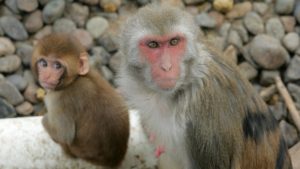 In 2015, there were 767,622 animals used for medical experiments in the US, the lowest level since the United States Department of Agriculture began keeping records in the early 1970s. That included roughly 138,000 rabbits, 98,000 hamsters, 11,000 sheep, 46,000 pigs; 20,000 cats, 61,000 dogs, 173,000 guinea pigs, 28,000 “other farm animals,” and nearly 62,000 “nonhuman primates.”
In 2015, there were 767,622 animals used for medical experiments in the US, the lowest level since the United States Department of Agriculture began keeping records in the early 1970s. That included roughly 138,000 rabbits, 98,000 hamsters, 11,000 sheep, 46,000 pigs; 20,000 cats, 61,000 dogs, 173,000 guinea pigs, 28,000 “other farm animals,” and nearly 62,000 “nonhuman primates.”
In 2016, the number of animals used for scientific testing rose to 820,812. Last year, it dipped slightly, to 792,168. Today, according to Pew, 52% of Americans are against animal testing. However, there have never been more nonhuman primates used for lab experimentsthan there are right now.
Increased funding from the National Institutes of Health (NIH), which supports a majority of US primate research, is one factorbehind the recent rise in primate testing. The other reason “the numbers are trending up [is] because these animals give us better data,” Jay Rappaport of the Tulane National Primate Research Center in Covington, Louisiana, told Science magazine. “We need them more than ever.”
Others disagree. Thomas Hartung, director of the Johns Hopkins University Center for Alternatives to Animal Testing believes the use of all lab animals, including primates, should be broadly reduced. Scientists and researchers overestimate the value of “almost all animal models,” says Hartung. Computer simulations and other methods that don’t involve the use of live animals can deliver the same results.
The NIH is currently in the process of rebidding at least two requestsfor proposals to maintain primate colonies in the US. One is currently located at the government-run Dale and Betty Bumpers Vaccine Research Center in Bethesda, Maryland. Another is split between Tulane University in New Orleans, Louisiana and two private companies in Rockville, Maryland, BioQual Inc and Advanced BioScience Laboratory.
Bumpers is focused on developing vaccines for HIV/AIDS, ebola, and influenza, the NIH website says. One of the newly-issued requests for proposal calls for maintaining a colony of up to 1,000 ”Indian-origin” rhesus macaques.
The NIH’s current contract with Tulane and the two Maryland firmsrequires those institutions to maintain facilities capable of housingover 900 nonhuman primates, 550 of which will be part of “breeding harems to achieve a production rate of 60-100 live births per year.” These monkeys will be used to test the efficacy of potential HIV vaccines, say the contracting documents.
Activist groups have long tried to stop researchers from experimenting on primates. University of California-Los Angeles neuroscientist J. David Jentsch, who uses rats and monkeys in his work, has gotten razor blades in the mail, groups of protesters marching in front of his home, and threatening emails. In 2009, Jentsch’s car was blown up in his driveway.
That same year, members of the Animal Liberation Front (ALF)firebombed the Austrian vacation home of former Novartis CEO Daniel Vasella, because they believed his company had ties to Huntingdon Life Sciences, a British animal-testing lab (Novartisdenied those allegations.) A month earlier, ALF activists stole Vasella’s late mother’s ashes from a gravesite in Chur, Switzerland, and spray painted “Drop HLS Now” (referring to Huntingdon) on her headstone. Vasella’s sister’s grave was also vandalized. Novartis reported at least 10 other attacks on employees; two explosives were placed under two cars parked in Novartis board member Ulrich Lehner’s driveway in 2009, for example.
Former FBI agent Dana Ridenour spent nearly seven years inside the ALF, going undercover to infiltrate the organization on two separate cases. The activist community is relatively decentralized, she says. Some activists dedicate all of their efforts to protesting fur; others go after vivisectionists, or scientists who operate on animals while they’re awake.
“Then you’ll have another group of people that are out to try to save the primates,” says Ridenour. “They target labs, universities, march outside people’s homes. They feel like that’s the only means they have—they’ve tried to change the laws and that doesn’t work, so they resort to what we’ve labeled ‘domestic terrorism’ to try to protect the animals.”
Nevertheless, primates continue to be used in research labs—in growing numbers. The increase “represents both the state of the science and the importance of nonhuman primates,” said the NIH in a statement.
To that end, Jon Levine, director of the Wisconsin National Primate Research Center, is disturbed by the current demand for marmosets by neuroscience researchers. The surge in primate demand, Levine told Science, is like “a 10-alarm fire that’s about to be set.”
“Primates have rich emotional and social lives, and suffer greatly when confined and used in laboratory experiments,” says theAmerican Anti-Vivisection Society. “In the wild, they live in groups, often with complex communication and familial social structures, which can be difficult to reproduce in captivity. Furthermore, primates are not just capable of developing relationships; social interaction is important for their psychological well-being. So important, in fact, that some primates will choose companionship over food.”

